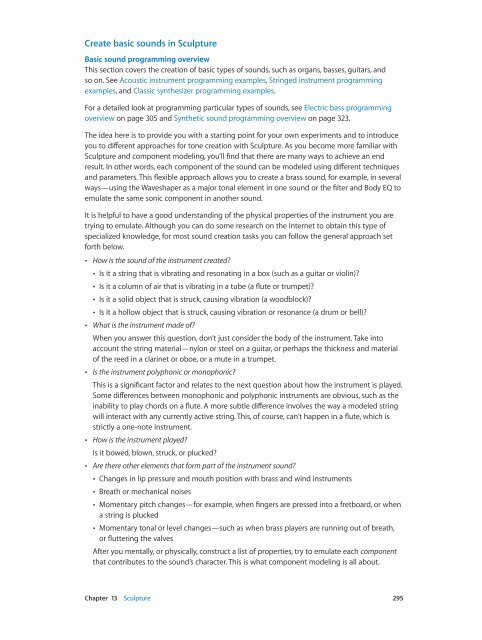Apple MainStage 3 Instruments - MainStage 3 Instruments
Apple MainStage 3 Instruments - MainStage 3 Instruments
Apple MainStage 3 Instruments - MainStage 3 Instruments
Create successful ePaper yourself
Turn your PDF publications into a flip-book with our unique Google optimized e-Paper software.
Create basic sounds in Sculpture<br />
Basic sound programming overview<br />
This section covers the creation of basic types of sounds, such as organs, basses, guitars, and<br />
so on. See Acoustic instrument programming examples, Stringed instrument programming<br />
examples, and Classic synthesizer programming examples.<br />
For a detailed look at programming particular types of sounds, see Electric bass programming<br />
overview on page 305 and Synthetic sound programming overview on page 323.<br />
The idea here is to provide you with a starting point for your own experiments and to introduce<br />
you to different approaches for tone creation with Sculpture. As you become more familiar with<br />
Sculpture and component modeling, you’ll find that there are many ways to achieve an end<br />
result. In other words, each component of the sound can be modeled using different techniques<br />
and parameters. This flexible approach allows you to create a brass sound, for example, in several<br />
ways—using the Waveshaper as a major tonal element in one sound or the filter and Body EQ to<br />
emulate the same sonic component in another sound.<br />
It is helpful to have a good understanding of the physical properties of the instrument you are<br />
trying to emulate. Although you can do some research on the Internet to obtain this type of<br />
specialized knowledge, for most sound creation tasks you can follow the general approach set<br />
forth below.<br />
••<br />
How is the sound of the instrument created?<br />
••<br />
Is it a string that is vibrating and resonating in a box (such as a guitar or violin)?<br />
••<br />
Is it a column of air that is vibrating in a tube (a flute or trumpet)?<br />
••<br />
Is it a solid object that is struck, causing vibration (a woodblock)?<br />
••<br />
Is it a hollow object that is struck, causing vibration or resonance (a drum or bell)?<br />
••<br />
What is the instrument made of?<br />
When you answer this question, don’t just consider the body of the instrument. Take into<br />
account the string material—nylon or steel on a guitar, or perhaps the thickness and material<br />
of the reed in a clarinet or oboe, or a mute in a trumpet.<br />
••<br />
Is the instrument polyphonic or monophonic?<br />
This is a significant factor and relates to the next question about how the instrument is played.<br />
Some differences between monophonic and polyphonic instruments are obvious, such as the<br />
inability to play chords on a flute. A more subtle difference involves the way a modeled string<br />
will interact with any currently active string. This, of course, can’t happen in a flute, which is<br />
strictly a one-note instrument.<br />
••<br />
How is the instrument played?<br />
Is it bowed, blown, struck, or plucked?<br />
••<br />
Are there other elements that form part of the instrument sound?<br />
••<br />
Changes in lip pressure and mouth position with brass and wind instruments<br />
••<br />
Breath or mechanical noises<br />
••<br />
Momentary pitch changes—for example, when fingers are pressed into a fretboard, or when<br />
a string is plucked<br />
••<br />
Momentary tonal or level changes—such as when brass players are running out of breath,<br />
or fluttering the valves<br />
After you mentally, or physically, construct a list of properties, try to emulate each component<br />
that contributes to the sound’s character. This is what component modeling is all about.<br />
Chapter 13 Sculpture 295
















